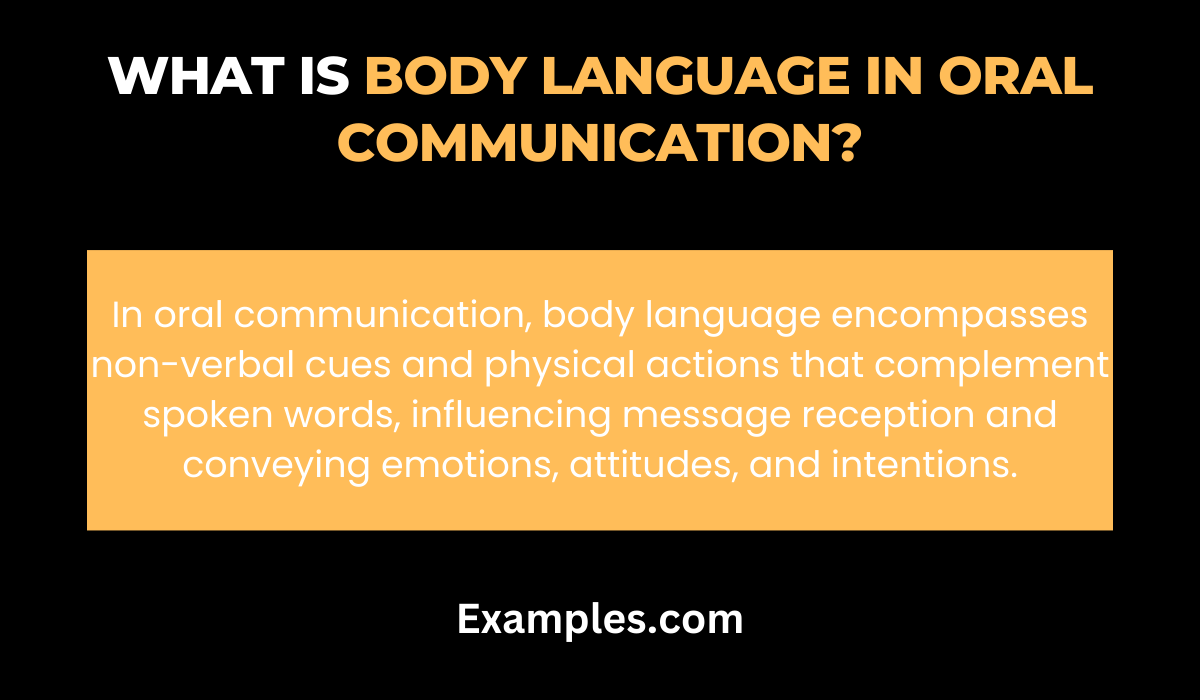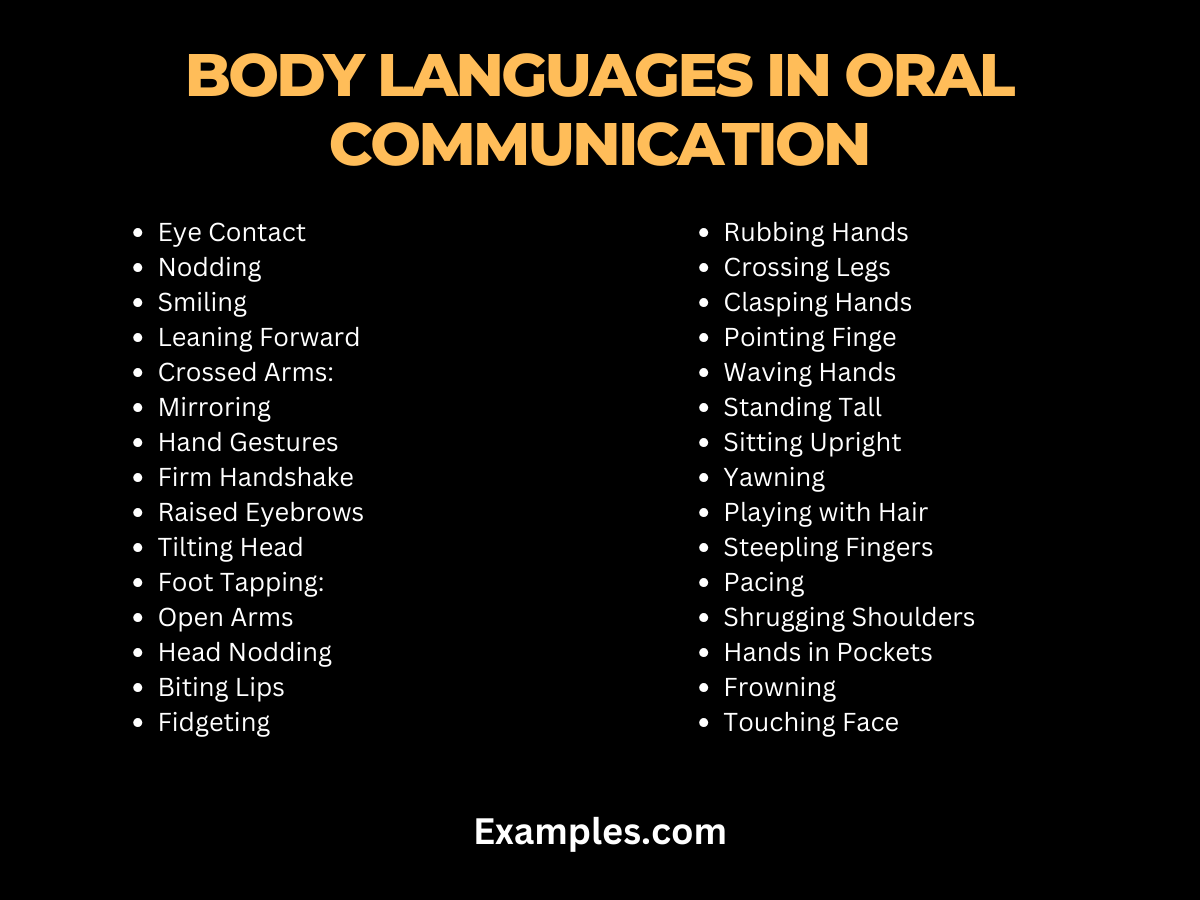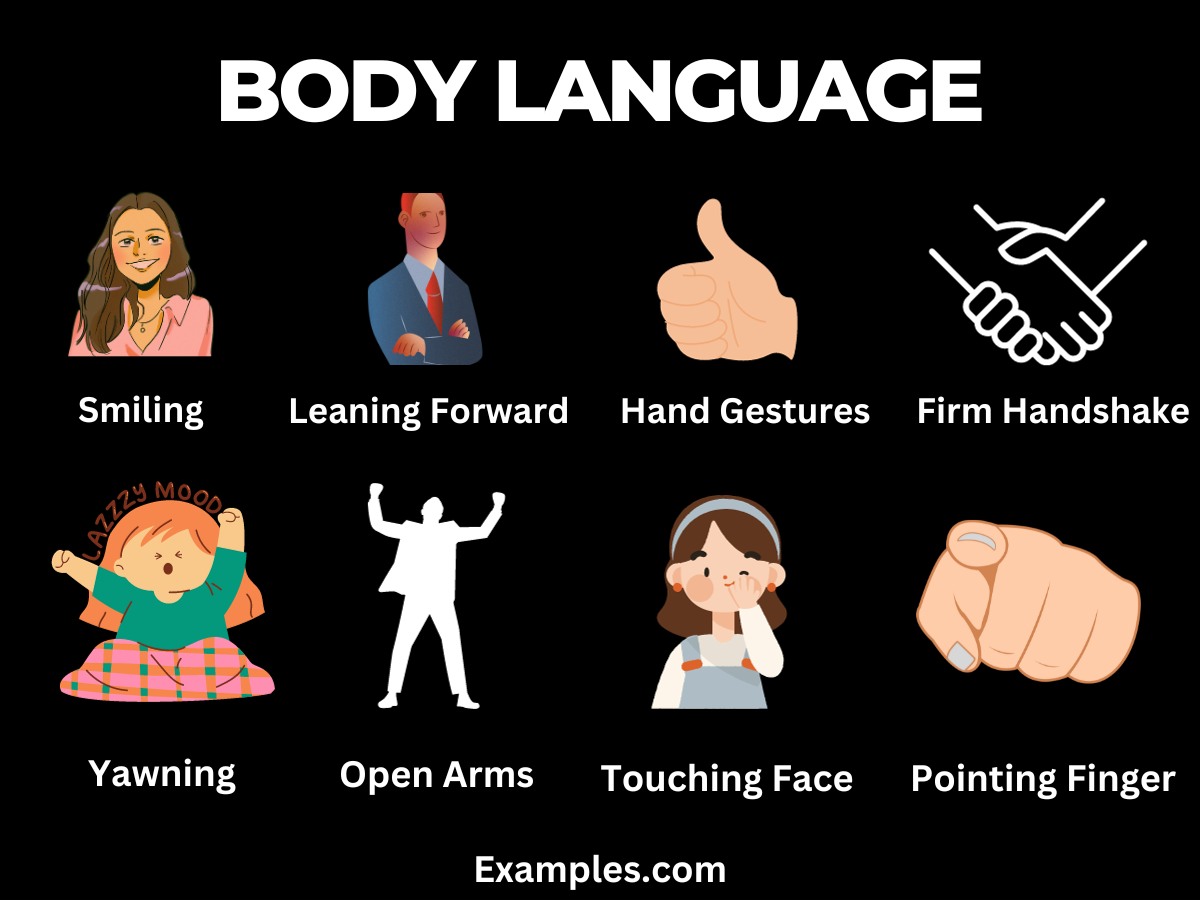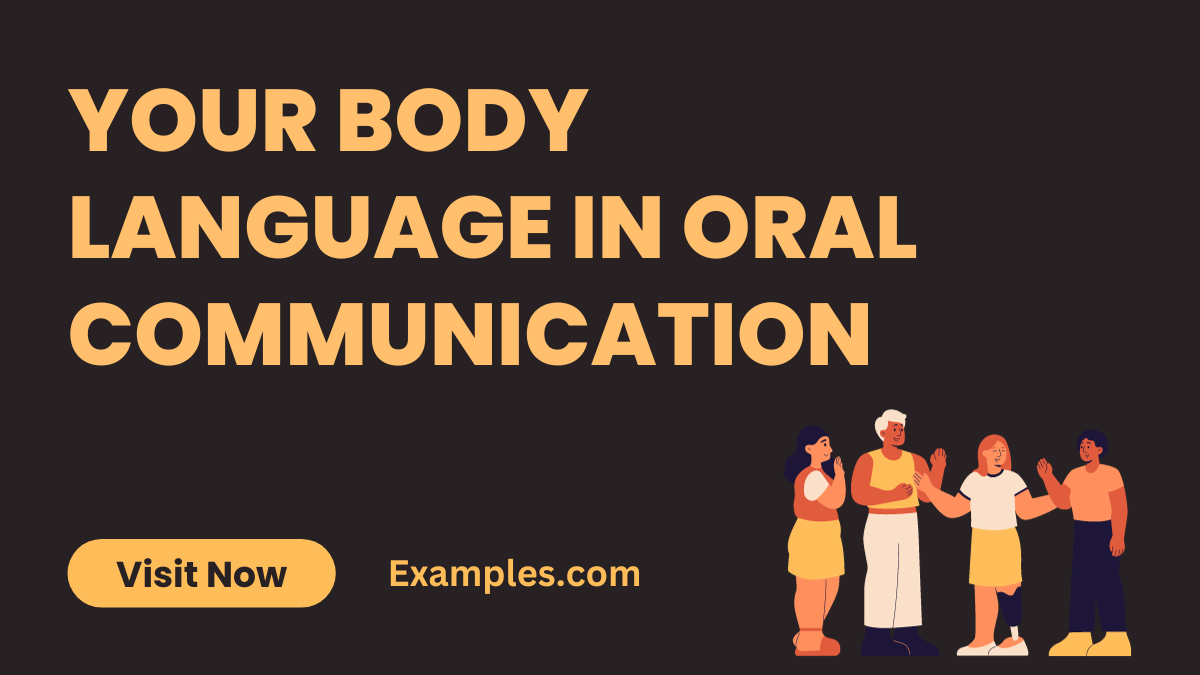Your Body Language in Oral Communication
Understanding the nuances of body language is vital in enhancing your Oral Communication Skills. This comprehensive guide delves into the subtle yet powerful realm of non-verbal cues. We explore how gestures, facial expressions, and posture can significantly influence the impact of your spoken words. Whether in a business meeting or a casual conversation, mastering the art of body language can transform your communicative effectiveness. Learn the secrets to using your physical presence to complement and reinforce your verbal message, making your interactions more engaging and impactful.
What is Body Language in Oral Communication?

Body language in Oral Communication refers to the non-verbal cues and physical behaviors that accompany spoken words. It includes gestures, facial expressions, posture, eye contact, and movements, which can reinforce, contradict, or enhance the verbal message. Effective body language can significantly impact how the message is received and interpreted, playing a crucial role in conveying emotions, attitudes, and intentions.
What is the Best Example of Body Language in Oral Communication?

A prime example of body language in oral communication is maintaining eye contact while speaking. This simple act conveys confidence, attentiveness, and engagement, fostering a stronger connection with the audience. Additionally, gestures like nodding can signify agreement or understanding, enhancing the interaction’s effectiveness and clarity.
30 Body Languages in Oral Communication

Body language plays a pivotal role in enhancing Oral Communication Skills. Mastering these non-verbal cues can transform how messages are conveyed and received, adding depth and clarity to interactions. Here are 30 distinct body languages, each with an example and explanation

- Eye Contact: Conveys focus and sincerity.Eye contact is a powerful tool in Oral Communication, bridging the gap between speaker and listener. It establishes a connection, conveying sincerity and confidence. In various settings, from formal presentations to casual conversations, maintaining appropriate eye contact is key to effective communication. It ensures that the audience feels acknowledged and engaged, thereby enhancing the overall impact of the message delivered.
Example: While discussing a project, maintain steady eye contact to show engagement. - Nodding: Indicates understanding or agreement.Nodding during conversations is a non-verbal affirmation, signaling understanding or agreement. In Oral Communication, it’s a subtle yet impactful way to show active participation. Whether in meetings, negotiations, or casual talks, nodding appropriately can encourage speakers, indicate comprehension, and foster a positive communicative environment. It’s a simple gesture with powerful implications, enhancing the flow and effectiveness of verbal exchanges.
Example: Nod gently during a conversation to signal agreement with the speaker’s point. - Smiling: Reflects friendliness and positivity.Smiling plays a vital role in Oral Communication. It’s a universal symbol of friendliness and approachability, setting a positive tone for interactions. In professional or personal settings, a genuine smile can break barriers, ease tensions, and create a welcoming atmosphere. It’s not just about displaying happiness; it’s a strategic tool that enhances the speaker’s likability and receptiveness, making the communication more effective and pleasant.
Example: Smile when greeting someone to create a welcoming atmosphere. - Leaning Forward: Shows interest and engagement.Leaning forward during a conversation signifies keen interest and engagement. In the realm of Oral Communication, this body language conveys a strong message of attentiveness and curiosity. Whether it’s a business meeting, academic discussion, or personal dialogue, leaning in slightly can demonstrate that you are fully invested in the conversation, encouraging open and meaningful communication. It’s a non-verbal cue that effectively complements verbal interactions.
Example: Lean in slightly during a meeting to demonstrate attentiveness. - Crossed Arms: Can suggest defensiveness or discomfort.Crossed arms often suggest a defensive or closed-off attitude in Oral Communication. This posture can create a barrier, conveying a sense of disinterest or resistance. In professional and personal interactions, it’s important to be aware of this gesture, as it can hinder open communication and rapport building. Understanding this body language and maintaining a more open stance can lead to more productive and positive exchanges.
Example: Avoid crossing arms to keep a more open and receptive posture. - Mirroring: Imitating the listener’s body language to build rapport.Mirroring, the subtle replication of another’s body language, is a powerful aspect of Oral Communication. It creates a sense of empathy and understanding, fostering a deeper connection between the communicators. In various settings, mirroring can be employed to align more closely with the speaker, thereby enhancing rapport and trust. It’s a non-verbal way to show you are in sync with the other person, making the conversation more effective and engaging.
Example: Subtly mimic the speaker’s gestures to foster a connection. - Hand Gestures: Enhances the emphasis on spoken words.Hand gestures add dynamism and clarity to Oral Communication. They can emphasize points, illustrate ideas, and convey emotions more vividly. In different communicative contexts, whether presenting, teaching, or conversing, effective use of hand gestures can greatly enhance the message’s impact. They help in breaking down complex information, making the communication more interactive and understandable.
Example: Use hand gestures to highlight key points during a presentation. - Firm Handshake: Represents confidence and professionalism.A firm handshake in Oral Communication signifies professionalism and confidence. It’s often the first non-verbal interaction in many professional encounters, setting the tone for the forthcoming communication. A solid handshake conveys respect and establishes a positive, confident impression. In various professional scenarios, mastering this gesture can lead to more successful networking and rapport building.
Example: Offer a firm handshake when meeting someone to convey confidence. - Raised Eyebrows: Can express surprise or inquiry.Raised eyebrows can express surprise, skepticism, or curiosity in Oral Communication. This facial gesture is a quick and effective way to non-verbally interact within a conversation, providing visual cues about one’s reactions or feelings. When used appropriately, it can add nuance to verbal communication, helping to underscore the emotional undertone of the message.
Example: Raise eyebrows to show intrigue or ask for clarification. - Tilting Head: Suggests curiosity or Tilting contemplation the head during conversations often signifies interest and thoughtfulness in Oral Communication. This gesture can convey that you are actively listening and processing the information being shared. In various communicative situations, a tilted head can make the speaker feel heard and valued, thereby enhancing the quality and effectiveness of the interaction.
Example: Tilt your head when listening to demonstrate interest in the topic. - Foot Tapping: May indicate impatience or nervousness.Foot tapping often indicates restlessness or impatience in Oral Communication. This involuntary action can distract listeners and convey nervousness or urgency. In settings where clear and calm communication is essential, it’s important to be mindful of such movements. Controlling foot tapping can help in maintaining a composed demeanor, ensuring the message is delivered effectively without unintended distractions.
Example: Avoid foot tapping to prevent giving off anxious vibes. - Open Arms: Symbolizes openness and honesty.Using open arms in Oral Communication symbolizes openness and receptivity. This welcoming gesture can break down barriers and encourage free-flowing dialogue. In various interpersonal interactions, open arms can create a trusting and comfortable environment, facilitating effective and open exchanges of ideas and feelings.
Example: Keep arms open during a discussion to seem more approachable. - Head Nodding: Shows encouragement or agreement.Head nodding is a universal sign of agreement or acknowledgment in Oral Communication. It’s an effective way to show you are engaged and understanding the speaker without interrupting the flow of conversation. In diverse communicative scenarios, this simple gesture can affirm the speaker’s points and encourage them to continue, fostering a positive and interactive communication dynamic.
Example: Nod your head while someone speaks to show you are following along. - Biting Lips: Can reflect nervousness or hesitation.Biting lips can reflect uncertainty or nervousness in Oral Communication. This subtle gesture might indicate hesitation or the processing of thoughts. Being conscious of this habit and avoiding it can help maintain a more confident and assured appearance during conversations, ensuring that the focus remains on the spoken message rather than the non-verbal cues.
Example: Refrain from biting your lips to maintain a composed appearance. - Fidgeting: Often signifies discomfort or restlessness.Fidgeting, such as shifting weight or playing with objects, often signals discomfort or distraction in Oral Communication. It can detract from the message being conveyed, as it might suggest a lack of confidence or focus. In professional or personal communication, minimizing fidgeting is crucial for maintaining an aura of composure and ensuring that the verbal message is received without misunderstanding.
Example: Minimize fidgeting to appear more composed and focused. - Touching Face: Can indicate thinking or uncertainty.Frequently touching one’s face during conversation can indicate contemplation or uncertainty in Oral Communication. This gesture might be perceived as a sign of nervousness or indecisiveness. Being aware of this habit and reducing it can help in presenting a more confident and composed demeanor during interactions.
Example: Avoid touching your face frequently, as it might suggest nervousness. - Rubbing Hands: Implies anticipation or eagerness.Rubbing hands together can convey anticipation or eagerness in Oral Communication. This gesture is often associated with excitement or preparing for an important point. In various communication scenarios, using this gesture at the right moment can effectively express enthusiasm or readiness, adding a dynamic element to the interaction.
Example: Rub hands together when discussing an exciting idea. - Crossing Legs: Might be seen as a relaxed or defensive posture.Crossing legs can be interpreted as a relaxed or defensive posture in Oral Communication. This body language might convey comfort or, conversely, a closed-off attitude, depending on the context. Being mindful of how leg posture can be perceived, and adjusting it to suit the communication setting, can enhance the effectiveness and comfort level of the interaction.
Example: Cross legs subtly if comfortable, ensuring it doesn’t appear defensive. - Clasping Hands: Shows earnestness or anticipation.Clasping hands often signifies earnestness or anticipation in Oral Communication. This gesture can indicate that the speaker is deeply engaged in the topic or making an important point. Used judiciously, it can add emphasis and sincerity to the message being conveyed.
Example: Clasp hands together when making an important point. - Pointing Finger: Can be used for emphasis but may appear aggressive.Pointing with a finger can be a powerful gesture in Oral Communication, used for emphasis or direction. However, it may also be perceived as aggressive or confrontational. It’s important to use this gesture appropriately, ensuring that it enhances the communication without causing discomfort or appearing overly authoritative.
Example: Use pointing sparingly to avoid seeming confrontational. - Waving Hands: Signifies greeting or drawing attention.Waving hands is a friendly gesture often used for greeting or attracting attention in Oral Communication. It’s a sign of approachability and openness, creating a positive and welcoming environment. Employing this gesture can make interactions more engaging and amicable.
Example: Wave to acknowledge someone’s presence in a friendly manner. - Standing Tall: Exudes confidence and authority.Standing tall is not just a posture; it’s a powerful non-verbal communication tool. When you stand upright, with shoulders back and head held high, it signals self-assurance and command. This posture is particularly effective during public speaking or in leadership situations, as it conveys a sense of confidence and authority to the audience.
Example: Stand upright to project confidence during a speech. - Sitting Upright: Shows attentiveness and respect.Sitting upright is an important aspect of body language in professional settings. It demonstrates that you are fully engaged and respectful of the situation at hand. An upright sitting posture, with a straight back and open shoulders, indicates active participation and attentiveness, making it ideal for meetings and discussions.
Example: Sit upright in meetings to demonstrate active participation. - Yawning: Can indicate boredom or fatigue.Yawning, often seen as a sign of boredom or fatigue, can be perceived as disrespectful in certain settings. While it’s a natural response, it’s important to manage it tactfully, especially in professional or social settings.
Example: Cover your mouth if you need to yawn, to maintain politeness. - Playing with Hair: Might be perceived as a sign of insecurity or distraction.Playing with hair during meetings or conversations might be perceived negatively, often as a sign of insecurity, nervousness, or distraction. It’s important to be mindful of this habit as it can detract from the professionalism you wish to project.
Example: Avoid playing with your hair to stay focused and appear professional. - Steepling Fingers: Indicates confidence or deep thought.Steepling fingers, where the fingers are pressed together while the palms are separated, is a gesture commonly associated with confidence, authority, or deep thought. This gesture is often used in situations where someone is making an important point or contemplating a decision.
Example: Steeple fingers when making a thoughtful point. - Pacing: Can show restlessness or help stimulate thought.Pacing back and forth can be a sign of restlessness or nervousness, but it can also be a method to stimulate thinking and creativity. In some contexts, pacing can help in organizing thoughts and coming up with innovative solutions.
Example: Pace thoughtfully if it helps your thinking process during a brainstorm. - Shrugging Shoulders: Implies uncertainty or indifference.Shrugging shoulders is a universal gesture for indicating uncertainty, indifference, or lack of knowledge about a particular subject. It’s a non-verbal way of communicating that you don’t have the answer or are indifferent to the question or situation.
Example: Shrug shoulders when you genuinely don’t know the answer. - Hands in Pockets: Can indicate casualness or discomfort.Putting hands in pockets might be seen as a casual or relaxed posture, but in some cases, it can also indicate discomfort, nervousness, or a lack of confidence. In professional settings, it’s generally advisable to avoid this posture.
Example: Keep hands out of pockets for a more engaged and open stance. - Frowning: Expresses disagreement or discontent.Frowning is often a spontaneous reaction to disagreement or discontent. While it’s a natural expression, it’s important to manage it appropriately, especially in a professional context where maintaining respect and diplomacy is key.
Example: Frown subtly if you disagree with a point, while remaining respectful.
Why is Body Language Important in Oral Communication?
- Enhances Credibility: Effective body language boosts credibility in oral communication. For example, maintaining eye contact shows confidence and honesty, making your words more believable.
- Improves Clarity: Using gestures can clarify complex points in oral communication. For instance, using hand movements to indicate size or direction helps listeners understand your message better.
- Engages the Audience: Effective body language keeps the audience engaged. Nodding and smiling can create a connection, making your oral communication more impactful.
- Conveys Confidence: Confident body language, like standing tall, signifies self-assurance, making your oral communication more persuasive.
- Displays Enthusiasm: Expressive body language, such as animated gestures, shows enthusiasm, which can be contagious in oral communication.
- Controls the Tone: The right body language helps control the tone of oral communication. Leaning forward can show interest and seriousness, impacting how your message is received.
- Facilitates Feedback: Observing audience body language provides immediate feedback during oral communication, allowing you to adjust your approach on the spot.
- Builds Rapport: Mirroring the body language of your audience can build rapport, enhancing the effectiveness of oral communication.
- Non-verbal Emphasis: Strategic use of body language, like pausing and gesturing, adds emphasis to key points in oral communication.
- Manages Nervousness: Controlled body language can help manage nervousness, ensuring your oral communication remains smooth and effective.
How to Improve Body Language in Oral Communication?
- Maintain Eye Contact: Eye contact establishes trust and connection. When speaking, maintain eye contact to engage your audience. This shows confidence and sincerity in your oral communication.
- Use Gestures Sparingly: Overdoing gestures can be distracting. Use them to emphasize points and add energy to your oral communication.
- Practice Positive Posture: Stand or sit upright; avoid slouching. A positive posture in oral communication conveys confidence.
- Facial Expressions: Match your expressions with your words. Smiling can make your oral communication more approachable.
- Avoid Fidgeting: Constant movement can be distracting. Stay composed to keep the focus on your oral communication.
- Modulate Your Voice: Use variations in tone and pace to keep your oral communication lively and engaging.
- Dress Appropriately: Your attire should suit the context of your oral communication, enhancing your message.
- Use Proxemics Wisely: Be mindful of personal space in your oral communication. Too close can be intimidating, too far can seem disengaged.
- Mirror Your Audience: Subtly mimicking the body language of your audience can create rapport in oral communication.
- Feedback: Observe audience reactions and adjust your body language accordingly for effective oral communication.
Role of Body Language in Oral Communication
- Expressing Emotions: Body language conveys emotions effectively in oral communication. A smile can express friendliness, while crossed arms might indicate defensiveness.
- Reinforcing Statements: Gestures reinforce verbal messages in oral communication. For example, nodding while agreeing strengthens the message.
- Indicating Engagement: Leaning in or nodding shows you are actively engaged in oral communication.
- Highlighting Important Points: Strategic pauses and gestures draw attention to key points in oral communication.
- Providing Cues: Body language offers cues about the speaker’s state of mind, such as confidence or uncertainty, in oral communication.
- Enhancing Persuasiveness: Persuasive body language, like open gestures, can make arguments more compelling in oral communication.
- Setting the Communication Tone: Body language sets the tone, whether formal or informal, in oral communication.
- Facilitating Clarity: Clear body language helps avoid misunderstandings in oral communication.
- Managing the Flow: Using hand gestures can help manage the flow and transitions in oral communication.
- Reflecting Cultural Differences: Understanding cultural variations in body language is crucial for effective global oral communication.
Body language plays a pivotal role in enhancing the effectiveness of oral communication. Mastering this art involves understanding its impact, practicing various non-verbal cues, and aligning them with spoken words. This comprehensive guide offers insights and practical tips to refine your body language, making your oral communication more engaging, persuasive, and impactful.
In the conclusion, it would be beneficial to stress the importance of continual learning and adaptation in body language skills. This can be supported by linking to authoritative resources. One such resource could be Harvard University’s Program on Negotiation, which offers insightful articles and tips on communication and negotiation skills, accessible at Harvard PON. This link provides readers with advanced learning opportunities from a reputable educational source.



